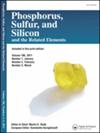Substituent influence of heteroatom on the novel remote N-heterocyclic silylenes (RNHSis) using density functional theory
IF 1.4
4区 化学
Q4 CHEMISTRY, INORGANIC & NUCLEAR
Phosphorus, Sulfur, and Silicon and the Related Elements
Pub Date : 2023-12-02
DOI:10.1080/10426507.2023.2223746
引用次数: 0
Abstract
In this work, we have compared and contrasted the stability, polarity, polarizability, frequency, band gap, charge distribution, and global reactivity of singlet (s) and triplet (t) states of the fused benzo-4-sila-1,4-dihydropyridine-4,4-diyl as the reference structure (1-s and 1-t) as well as the fused pyrrole congeners (2x-s, and 2x-t, x = NH, PH, AsH, O, S, and Se), using density-functional theory (DFT). According to frequency data, all singlet and triplet remote N-heterocyclic silylene (RNHSi) structures appear as minimum displaying a positive force constant. Every singlet silylene as ground state exhibits more stability than its corresponding triplet congener. Consistent with Hoffmannʼs findings, the fusion of one pyrrole ring with different heteroatoms stabilizes the corresponding RNHSi more than the fusion of one benzene ring. In going from 1-s to 2x-s species and substituting of NH, PH, AsH, O, S, and Se groups, higher singlet–triplet energy difference (ΔE s-t = E t – E s) and the higher band gap is found for 2NH-s and 2 O-s structures. Interestingly, the higher thermodynamic and kinetic stability of the optimized RNHSis than the synthesized Kiraʼs silylene makes them worthy of synthetic exploration. According to the distributed charge and FMO (the frontier molecular orbital) shapes, the more negative region is localized on pyridineʼs nitrogen and the less negative region is confined over pyrroleʼs nitrogen, while the positive charge is distributed on silylenic center. This phenomenon is inconsistent with the expected canonical forms for RNHSis.
基于密度泛函理论的杂原子取代基对新型远端n -杂环硅烯(RNHSis)的影响
本文章由计算机程序翻译,如有差异,请以英文原文为准。
求助全文
约1分钟内获得全文
求助全文
来源期刊
CiteScore
2.60
自引率
7.70%
发文量
103
审稿时长
2.1 months
期刊介绍:
Phosphorus, Sulfur, and Silicon and the Related Elements is a monthly publication intended to disseminate current trends and novel methods to those working in the broad and interdisciplinary field of heteroatom chemistry.

 求助内容:
求助内容: 应助结果提醒方式:
应助结果提醒方式:


